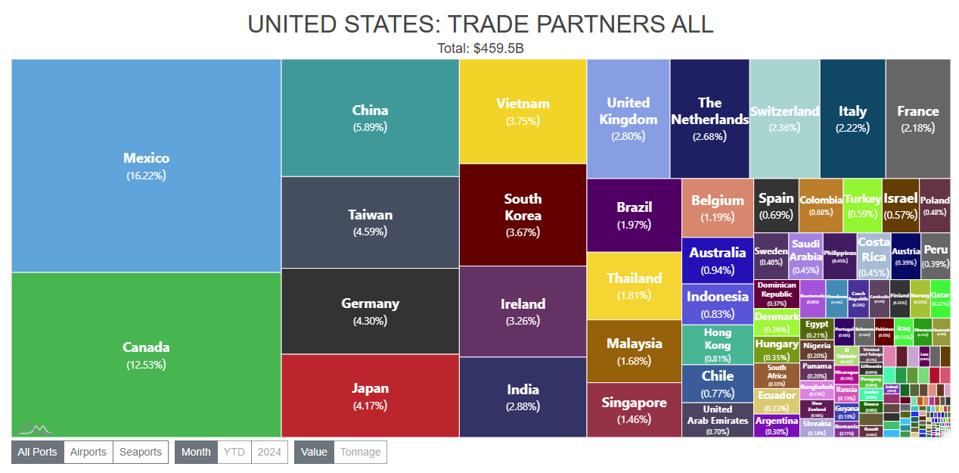


And then there were two. Once China sat atop the rankings of U.S. trade partners. Today, it ranks a ... More
China accounted for 5.89% of all U.S. trade in May, its lowest monthly percentage in more than 23 years, according to my analysis of the latest U.S. Census Bureau data. Is it the impact of President Trump’s tariffs or some sort of “rules of origin” trickery?
One thing that’s hard to dispute: It’s a remarkable shift.
Former President Joe Biden continued the tariffs on China that President Trump initiated during his ... More
Not long after President Trump entered the White House for his first term, China accounted for 17.77% of all U.S. trade, three times more.
Months later, Trump would begin the trade war that continued through the presidency of Joe Biden, and which he has now intensified.
It has altered the U.S. export-import landscape in many ways. But not all ways.
Since one of Trump’s key goals has been to reduce the U.S. merchandise trade deficit with the world, it’s fair to say that not only has not worked, it has failed. The U.S. deficit has risen six of the last eight years, topping $1 trillion the last four. It has only shifted.
At the end of 2018, the U.S. deficit with China was five times that of any other nation’s. Today, it is now only slightly larger than Mexico’s – and less than Mexico’s and Canada’s combined for the first time in decades.
While the U.S. deficit with China has fallen 29.37%, the deficit with Mexico, Canada and other leading trade partners have registered sometimes staggering increases:
Perhaps, you might be thinking, it’s better to have deficits with your allies than China.
Well, Trump’s “Liberation Day” tariffs announced April 2, paused until July 9 and now largely extended to Aug. 1, threatened these countries and the rest of the world with tariffs of varying amounts.
Why? The countries listed above, with the exception of Canada, were largely targeted because of the presumption that China had been gaming the system to alter the “country of origin” labeling and save on steep U.S. tariffs, with a particular emphasis on Vietnam. With more than 100 countries with which the United States has a trade suplus, the reasoning is less clear.
One byproduct of Trumps’ trade war with the world? Relations with U.S. allies are frayed, strained at best.
Another byproduct of this global trade war, is that while the U.S. deficit has increased, another key metric has fallen – the percentage of U.S. trade vs. an import.
While most years for the last several decades the ratio between exports and imports have been relatively steady at about 40% exports, even as the deficit increased, something different is happening this year. That balance has fallen steeply by historical norms, even as the deficit has continued to rise.
Against this backdrop, what follows is a closer look at the remarkable shift away from products with “Made in China” labels entering the United States.
Exports are also at play. Again, just looking at the first five months of the 2018 and 2025, U.S. exports to China are down 12.49% while U.S. exports to the world are up 30.24%. While that’s a less-staggering difference, it is certainly staggering to U.S. exporters.
For exports, that means a $3.03 billion decrease in the value of oil shipped to China, once the leading market for U.S. exports and a country now relying on oil from Russia and Iran. It means a $2.54 billion decline in passenger vehicles and a $688.03 million decline in the primary motor vehicle parts category.
On the import side, it means a decline of $12.86 billion in the cell phone and parts category, a $10.57 billion decline in computers. It means a decline of more than $2 billion in seats, TVs and computer monitors, and furniture and parts.
In summary, then, the change in the percentage of China’s U.S. trade between Trump’s first term and the first months of his second, is dramatic.
In simple terms, six of the 10 months when China’s trade with the United States was the highest over the last two decades occurred in Trump’s first term, with all but two before he announced the trade war in March of 2018.
And, now, in his first five months in office for which trade data is available, Trump has been president for three of the four lowest, the others being March and April.
At least according to the official U.S. government data, it’s hard to make the case that U.S. trade with China has not been decoupled. A percentage drop from above 17.77% to 5.89% would support that.
The impact? The U.S. deficit has continued to rise. Through Trump’s first term. Through Biden’s. And, so far, through the first months of Trump’s second term.
In addition, relations with allies are frayed at worst, strained at least.


